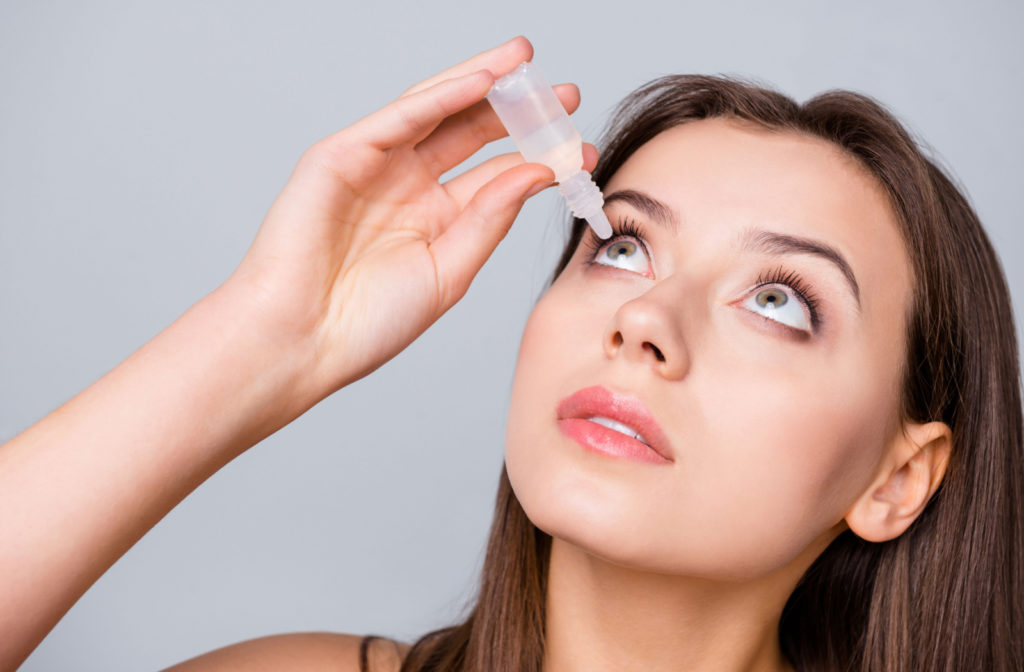Having dry eyes can cause a wide range of uncomfortable symptoms, including redness, irritation, and a gritty or burning sensation in your eyes—but can it also cause headaches?
Some individuals may experience dry eye symptoms and headaches at the same time. However, there is insufficient research to conclude that dry eye can cause headaches.
If you are experiencing recurring headaches with or without other dry eye symptoms, it’s a good idea to consult your eye care provider.
Your eye doctor’s office is the best place to get a dry eye diagnosis and determine a treatment plan for lasting relief. Additionally, headaches may be a sign of other vision or health problems unrelated to dry eyes, and a visit with your eye doctor may help determine the root cause of your headaches.
What is Dry Eye?
Dry eye disease is a widespread eye condition that impacts millions of Americans. Dry eye occurs when you don’t produce enough tears or when your tears evaporate too quickly. This can lead to several symptoms, including:
- Stinging, burning, or scratchy eyes
- Redness
- Excessive watering
- Eye fatigue
- Blurry vision
- Sensitivity to light
Both dry eyes and headaches can present similar symptoms, including eye fatigue and sensitivity to light, so in some cases, it may be difficult to determine which condition is causing your symptoms.
What Causes Dry Eye?
Many health, demographic, and environmental factors can increase your risk of developing dry eye, including:
- Aging: As we age, it’s normal for our tear production to slow down, which can lead to dry eyes.
- Medical conditions: Certain medical conditions such as rheumatoid arthritis, Sjögren’s Syndrome, and thyroid disease can increase your risk of dry eye.
- Medications: Some medications, including antihistamines, decongestants, and antidepressants, can reduce tear production and contribute to dry eye.
- Environmental factors: Exposure to dry, windy, or dusty environments can cause irritation and dry eyes. Prolonged screen time may also contribute to dry eye symptoms.
Can Dry Eye Cause Headaches?
Dry eye and headaches are two common conditions that can significantly impact your quality of life. While they are not always directly related, it’s possible that dry eye symptoms can contribute to headaches.
Dry eyes and headaches can have similar triggers. For example, prolonged screen use can lead to digital eye strain, which causes both dry eyes and headaches.
Eye strain, in general, can be an uncomfortable part of living with dry eyes. When your eyes are not sufficiently lubricated, you may have to strain to focus your vision. This straining may contribute to headaches.
A handful of studies demonstrate that individuals who experience migraine headaches are more likely to be diagnosed with dry eye disease. According to a 2020 study, participants diagnosed with migraine headaches were 20% more likely to have dry eyes than their non-migraine counterparts.

How to Manage Dry Eye & Headaches
To find effective and lasting relief from both dry eyes and headaches, it’s important to understand the underlying cause of both conditions.
The simplest way to determine if your dry eye and headaches are related is by treating your dry eye directly. If your headaches persist even when your other dry eye symptoms are gone, there is likely another cause for your headaches.
If you’re experiencing dry eye symptoms or headaches, your first step should be to schedule an eye exam. After a comprehensive eye exam, your eye doctor can work with you to develop a treatment plan with your unique eye care and lifestyle needs in mind.
How to Treat Dry Eye
There are a number of at-home and in-office treatment options that can help provide relief from dry eye symptoms. Ask your eye doctor before starting any new treatments.
Treatment options may include:
- Artificial tears: Over-the-counter eye drops can help replenish your eyes with the hydration they are missing. Talk to your eye doctor to help determine the best eye drop for your specific needs.
- Warm compress: Treatment with a warm compress can help unblock your meibomian glands and restore healthy tear production.
- Prescription medications: Some individuals may require prescription medication to reduce inflammation or promote tear production. Medication may come in the form of pills, gel, or eye drops.
How to Prevent Dry Eye & Headaches
In addition to the treatment options we discussed above, there are additional lifestyle and environmental changes that you can make to help promote hydrated and healthy eyes.
- Stay hydrated: Drinking plenty of water can help keep your eyes and body hydrated, which can promote healthy tear production and prevent headaches.
- Change your diet: Omega-3 fatty acids are important in healthy tear production. Ensure you get enough omega-3s by adding fish, nuts (especially walnuts), and flaxseed to your diet.
- Take breaks from digital devices: Prolonged use of digital devices can contribute to both dry eye and headaches. Follow the 20-20-20 rule (every 20 minutes, take a 20-second break and look at something 20 feet away) to rest your eyes and prevent eye strain.
- Adjust your environment: If you live in a dry environment or frequently use fans or an air conditioner, try adding a humidifier to your space. Wear sufficient eye protection in dry, dusty, or windy environments to prevent irritation and dryness.
Find Relief from Dry Eye
It’s possible to find lasting relief from both dry eye and headaches. The Eye Gallery team is here to support your eye care needs, including dry eye therapy. Contact our office to book an exam and work towards lasting relief from dry eye symptoms and headaches today!




